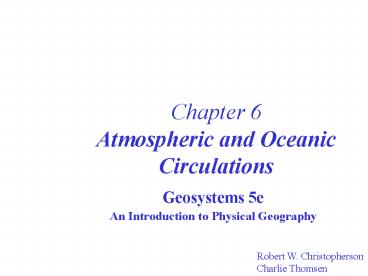Chapter 6 Atmospheric and Oceanic Circulations - PowerPoint PPT Presentation
1 / 75
Title:
Chapter 6 Atmospheric and Oceanic Circulations
Description:
Katabatic winds. Land-Sea Breezes. Figure 6.19. Figure 6.21. Monsoonal Winds. Mountain Winds ... Katabatic. Winds. Mountain Winds Katabatic. Winds. Oceanic ... – PowerPoint PPT presentation
Number of Views:106
Avg rating:3.0/5.0
Title: Chapter 6 Atmospheric and Oceanic Circulations
1
Chapter 6Atmospheric and Oceanic Circulations
- Geosystems 5e
- An Introduction to Physical Geography
Robert W. Christopherson Charlie Thomsen
2
Figure 6.13
3
Poles Cold Decending Air
Tropics Hot Rising Air
4
Single circulation cell
Poles Cold Decending Air
Tropics Hot Rising Air
5
Coriolis Due to the rotation of the earth
Poles Cold Decending Air
Tropics Hot Rising Air
Rotation
6
(No Transcript)
7
Coriolis Due to the rotation of the earth
Poles Cold Decending Air
Tropics Hot Rising Air
Rotation
8
Coriolis Due to the rotation of the earth
Poles Cold Decending Air
Tropics Hot Rising Air
Rotation
9
3 circulation cells
Poles Cold Decending Air
Tropics Hot Rising Air
10
3 circulation cells per hemisphere
Tropics Hot Rising Air
11
3 circulation cells per hemisphere
Tropics Hadley Cells
NE Trade Winds
ITCZ - doldroms
SE Trade Winds
ITCZ - Inter Tropical Convergence Zone
12
Subtropical Jet Stream
Westerlies
Mid-latitudes
Sub-tropical high Horse Lat.
13
Cloud Cover
14
(No Transcript)
15
(No Transcript)
16
(No Transcript)
17
Surface Pressure
Polar High
Polar Low
Subtropical High
Tropical Low
18
General Atmospheric Circulation
Figure 6.13
19
Rossby Waves
Undulations in the polar front
Polar Jet Stream
20
Jet Streams
Polar Jet stream
Subtropical Jet
21
(No Transcript)
22
Driving Forces Within the Atmosphere
- Gravity
- Pressure Gradient Force
- Coriolis Force
- Friction Force
23
Barometer
Instrument used to measure air pressure
Figure 6.2
24
Weather Map www.weather.com
25
Pressure Gradient
Figure 6.7
26
(No Transcript)
27
Pressure Gradient
Figure 6.7
28
Pressure wind
29
Geostrophic wind
30
Wind movement because of Pressure gradient alone
Pressure Map view
Side view
31
Pressure CoriolisGeostrophic wind
Map View
Pressure only
Pressure coriolis Geostrophic wind
32
Coriolis Force
Figure 6.9
33
Coriolis animation
34
Pressure Coriolis Friction
Pressure coriolis Geostrophic wind
Pressure coriolis Friction
35
Wind movement because of Pressure gradient alone
Map view
36
Pressure Coriolis
37
Pressure Coriolis Friction
38
Pressure Coriolis Friction
Figure 6.8
39
Pressure gradient and wind
40
Coriolis Force
Figure 6.9
41
Coriolis Force
Figure 6.9
42
Coriolis Force
Figure 6.9
43
Surface vs. high winds
- Surface winds interact with the surface so there
is more friction. - High level winds do not interact as much with the
surface so they tend to be geostrophic winds.
44
500 mb Pressure Map (approx.5500m)
Figure 6.10
45
Atmospheric Patterns of Motion
- Primary High-Pressure and Low-Pressure Areas
- Upper Atmospheric Circulation
- Local Winds
- Monsoonal Winds
46
Global Barometric Pressure
Figure 6.11
47
Global Barometric Pressure
Figure 6.11
48
Primary High-Pressure and Low-Pressure Areas
- Equatorial low-pressure trough
- Polar high-pressure cells
- Subtropical high-pressure cells
- Subpolar low-pressure cells
49
Equatorial low-pressure trough
- Intertropical convergence zone (ITCZ)
- Trade winds
50
Polar high-pressure cells
- Polar easterlies
- Antarctic high
51
Subtropical high-pressure cells
- Westerlies
- Bermuda high
- Azores high
- Pacific high
Figure 6.14
52
Subpolar low-pressure cells
- Aleutian low
- Icelandic low
- Polar front
53
Figure 6.13
54
Figure 6.6
55
Isobaric pressure maps
- Show the elevation in the atmosphere that is (in
this example) at a pressure of 500 mb.
56
Isobaric pressure maps
57
(No Transcript)
58
Upper Atmospheric Circulation
- Rossby waves
- Jet stream
59
Rossby Waves
Undulations in the polar front
Figure 6.17
60
Jet Streams
Figure 6.18
61
Local Winds
- Land-sea breezes
- Mountain-valley breezes
- Katabatic winds
62
Land-Sea Breezes
Figure 6.19
63
Monsoonal Winds
Figure 6.21
64
Mountain WindsKatabaticWinds
65
Mountain Winds KatabaticWinds
66
Oceanic Currents
- Surface Currents
- Deep Currents
67
Major Ocean Currents
Figure 6.22
68
Deep Currents
Figure 6.23
69
http//cleo1.phys.tue.nl/michel/Utrecht/use/thc.h
tml
70
http//www.educnet.education.fr/obter/appliped/oce
an/theme/images/courants.gif
71
http//www-aviso.cls.fr/images/applications/marees
/circ_ther_uk.gif
72
Change in annual temperature 30 years after a
collapse of the thermohaline circulation Figure
courtesy of Michael Vellinga, Hadley Centre.
73
End of Chapter 6
- Geosystems 5e
- An Introduction to Physical Geography
Robert W. Christopherson Charlie Thomsen
74
Turning off thermohaline circulation Hadley
Centre The figure shows that with increased
surface freshening the meridional overturning
collapses and the sea-surface temperature (SST)
and surface air temperature become significantly
cooler.
75
National Weather Service 12 hour Forecast































